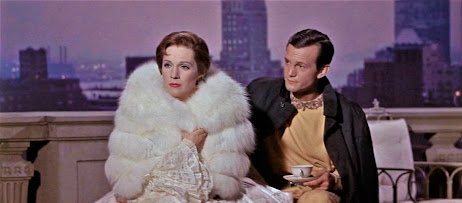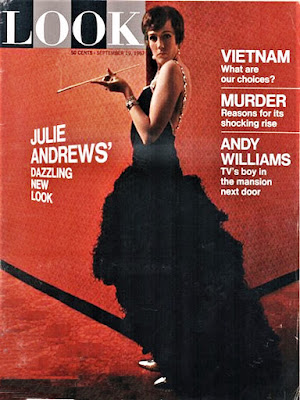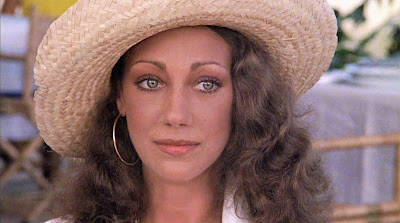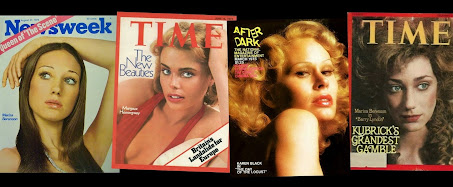"Crickey! I'm tired of playing bloody virgins." - Julie Andrews 1967
When music icon Debbie Harry was asked in a 2019 interview if she would be interested in seeing her life and the legacy of Blondie turned into a musical biopic, she responded: “I’m not so sure that I’m terribly fond of them. The way the industry works and the way the artist works within the industry, it’s all very similar. The only thing that’s different is the personality of the artist. It’s basically the same old story, only with different performers, different faces.”
Ms. Harry nailed it. Whether set in the worlds of music, movies, or theater, biographical films — no matter how creatively envisioned — suffer from an elemental sameness. A formulaic, 3-Act cycle of “rags-riches-rundown-redemption” that may make it easy for Hollywood to keep reselling the same product with different packaging, but encourages the production of films whose only distinction is budget size and the degree of talent, dynamism, and charisma of the particular performer tasked with the job of being the celebrity impersonator.
 |
| Seeing Double |
Los Angeles, October 1968: Julie Andrews & Hollywood newbie Barbra Streisand were the Doublemint Twins of Roadshow musicals. Star!, the eagerly-anticipated musical about the life of English Music Hall star Gertrude Lawrence, opened just three weeks after the premiere of Funny Girl, the equally anticipated biopic about Broadway star Fanny Brice. The similar films employed the same flashback framing device, each leading lady seated in a theater, looking back over her life.
(Note La Streisand's positively lethal nails.)
Funny Girl and Star! shared near-identical scenes depicting a theater neophyte “comically” bungling an ensemble number; winning over an audience with a dazzling solo; routinely bumping heads with a stern but avuncular employer; and, de rigueur of the genre, suffering for love in mink. Where these two films diverge is that its stars at the time were on very opposite career paths: Streisand seeking to establish a screen persona, Andrews hoping to shed one. This proved to be the difference that made all difference.
 |
| Dame Julie Andrews as Gertrude Lawrence |
 |
| Daniel Massey as Noel Coward |
I adore Julie Andrews, yet I’m something of a Johnny-come-lately where her films are concerned. The first Julie Andrews movie I ever saw was Thoroughly Modern Millie in 1967 when I was 10 years old, and I never saw another until 10 (which I loathed) in 1979. I was in my 40s when I got around to seeing Mary Poppins, The Sound of Music was unseen until 2015, and Star! only a few years before that.
I'm aware that my lifetime aversion to movies branded "clean" or "wholesome" is what kept me away from Andrews' two most iconic films, which is a pity, for they are both marvelous movies I would have loved as a child. However, Star!--an overstuffed musical "sure-fire hit" that wound up one of Hollywood's more legendary "crash and burn disasters" (I'm looking at you, Mame and Cats)--is just the kind of elephantine entertainment that would seem to be right up my aesthetic alley.
Discounting my usual complaint about overemphatic musical titles (those exclamation points!), I like to think I approached Star! with an open mind. But I gotta say, things got off to a very rocky start when this $14 million, spare no expense, travel the globe for locations musical epic hit me over the head with its “Fox contract player” casting vibe. Throughout the film, in scenes meant to be taking place in London & Paris, up pop familiar American TV faces like Eugene Roche (Mr. Ajax dish detergent) and Cathleen Cordell (stalwart of episodic TV) to break the illusion.
Some 15 minutes into the movie there’s a scene set in a meticulously re-created British Music Hall, but verisimilitude flies straight out the window the second I recognize the cockney drunk harassing a young Gertrude Lawrence to be the same drunk who harasses Darrin Stephens in every episode of Bewitched set in a bar: none other than TV's Charmin-pusher, Mr. Whipple, aka character actor Dick Wilson.
Then there are the two Parisian theater/cabaret impresarios played by American actors (Alan Oppenheim and Richard Angarola) chipping away at my already overtasked suspension of disbelief by speaking with cartoon French accents. Indeed, fans of Valley of the Dolls will recognize Angarola as Mr. Chardot, Sharon Tate’s, sleazy French "art film" director with the Pepé Le Pew intonation.
Hitting perhaps the hardest is the lineup of actors cast as glamorous Gertrude Lawrence's paramours. Looking over this bunch, my best guess is that in order for a family film to legitimize its leading lady juggling multiple lovers without benefit of marriage, they sought to cast leading men guaranteed to drive thoughts of sex out of anyone's mind on sight.
When production on The Sound of Music wrapped in 1964, Julie Andrews agreed to reteam with director Robert Wise and producer Saul Chaplin on a film about the life of Gertrude Lawrence. In the years before production began on Star!, Andrews completed three films (Torn Curtain, Hawaii, and Thoroughly Modern Millie), and most significantly, her fourth, The Sound of Music, had become a global cash-cow, cultural phenomenon, and 20th Century-Fox savior.
I have no idea how the Gertrude Lawrence biopic was originally envisioned in 1964, but by the time it morphed into the musical reunion of the creative team responsible for the then-highest-grossing motion picture in history, I suspect it outgrew itself.
 |
| "I don't know, but somewhere along the line, 'Shrinking Violet' got Sanforized" - Lucy Ricardo Costing nearly twice as much as The Sound of Music with less than a third of its plot and none of its warmth or humor, Star! is a gargantuan production for no other reason than Julie Andrews was the #1 box-office star and The Sound of Music had made a mint. |
Like many, I knew next to nothing about Gertrude Lawrence before seeing Star!, but years of reading show business memoirs and seeing movie biopics with "Story" tacked on the end (The Helen Morgan Story, The Eddy Duchin Story, etc.) resulted in a nagging sense of déjà vu from Star!'s depiction of Lawrence as a willful, ambitious girl from humble beginnings who achieves great fame as an actress, only to find happiness elusive because her professional desire to be “lots of different people" leaves her not knowing who she is or what she wants.
Presented as a series of episodic, tangentially-connected highlights and lowlights interspersed between splashy musical numbers, the essentially unremarkable events of Lawrence’s life story (at least as presented here) left me wondering how in the world anyone thought $14 million and three hours were necessary to tell it.
Perhaps criticizing the film’s script for being superficial, its characters undeveloped, its supporting cast serviceable, and production old-fashioned is quibbling. Star! was never really selling Gertrude Lawrence in the first place. As implied by the movie posters declaring “Julie Andrews as The Star!”, Julie Andrews—her singing, her dancing, her wigs, and her costumes (by Donald Brooks)—was the whole show. And I have to say, as a showcase for a sumptuously glamorized Andrews in all her singing and dancing glory, Star! is an outstanding film record that I'm overjoyed exists.
Andrews is in exceptionally fine voice and is clearly working her ass off. And rather than revisiting the tried-and-true, she's taking a genuine creative risk. I applaud actors (especially those labeled "stars") who try to spread their creative wings. Too many bad films have been made and far too many exciting talents dulled by surrendering to typecasting, going for the easy money, and pandering to fanbases obsessed with a star's “image.”
While some newspaper ads heralded, "Julie Andrews is a different Julie Andrews in STAR!" others promised, "Julie Andrews as you love her!"--whatever that meant. As it turns out, she was neither and both. Consequently, STAR!, like Gertrude Lawrence's character in the Broadway musical Lady in the Dark, suffered from not being able to make up its mind.
Although the sincerity of her effort shows (which may be part of the problem), with reluctance, I have to say I never found Andrews convincing for a moment as Gertrude Lawrence (1968 Maggie Smith would have been ideal). A reluctant observation because I really do like Julie Andrews SO much and think, in addition to being very talented, she is and always has been a humble and gracious class act and charming personality.
But for an actress who mostly exudes crisp efficiency and common sense to bring to life a character kindly described as an ill-tempered, hard-drinking, child-neglecting narcissist, Andrews needed the special handling and solid material that Doris Day received in Love Me or Leave Me, or what Mary Tyler Moore had with Ordinary People. Certainly something better than William Fairchild’s fatuous screenplay or Robert Wise's famously hands-off direction. Outside of its Michael Kidd choreographed and staged musical numbers, overall I feel Julie Andrews is poorly served by Star!, not the other way around.
 |
| 14-year-old Jenny Agutter (Logan's Run, Walkabout) as Gertrude's daughter Pamela Roper |
As movie musicals evolve (de-evolve?) into pyrotechnical CGI displays of machine-gun editing and flying camerawork, an old-school, studio-bound movie like Star! is not without its pleasures. I knew when I first saw it that Star! was going to be a film I’d add to my collection and rewatch...but likely never again in its entirety. And I was right...Star! has joined The Music Man, Paint Your Wagon, Nine, A Chorus Line, and Rent as one of my movie musical “Fast-Forward Favorites.”
WHAT I LOVE ABOUT THIS MOVIE - The Musical Sequences
My “Fast-Forward Favorites” are movies I visit most often with my finger poised over the FWD button on the remote so I can sidestep the unpleasantness and hone in exclusively on the joys. In nearly every film I place in this category, this means the musical numbers (George Cukor's The Women is one of the few non-musical films I most enjoy a la carte). The musical sequences in Star! hold a special sway over me because I fell in love with the movie's original soundtrack album long before I ever saw the film. I was a freshman in high school when I purchased the deluxe, photo-crammed, gate-fold Star! soundtrack LP for 99¢ in a remainder bin. It’s an absolutely brilliant song collection and I played it to death (still do) because it’s essentially a Julie Andrews concert album in disguise.
The use of music is where Star! differs from its 1968 look-alike Funny Girl. In Star!, like Cabaret, only four years earlier, all the songs and dances take place onstage or are sung in realistic performance. For the longest time, the discordant tone of the screenplay left me with the impression that the musical numbers in the film were unconnected to the action and that each time Dame Andrews breaks into song, the already overextended story grinds to a halt. But in rewatching the film in recent years and for this piece, I now see that most every song actually comments on the action or relates to Lawrence’s romantic and psychological conflicts. It's just that with the film's unwieldy structure, that particular thread isn't all that easy to find.
Favorite Musical Sequences
 |
| Dear Little Boy (Dear Little Girl) |
Ironic as hell that my top fave musical moment in this Herculean production is Julie Andrews just standing still and singing with that bell-clear voice of hers. Star! was my introduction to many of the standards and showtunes in the score, and this Gershwin song from 1926's Oh, Kay! (those damned exclamation points, again) is lovely.
 |
| Burlington Bertie from Bow |
 |
| The Physician |
 |
| The Saga of Jenny |
 |
| Damage Control |
When Star! flopped, Fox pulled the film from theaters early, lopped off nearly an hour, and released it to theaters in 1969 under the optimistic, totally nonsensical title Those Were The Happy Times. While I've always liked the original (misleadingly modern) movie poster, I am mad about and positively mesmerized by the sheer, absolute flop-sweat desperation of the re-issue poster. "Be Glad they still make pictures like this!" ...that's like when you complain about the lima beans and your mom responds, "Be glad there's food on your plate at all!" And what's up with that "demented flower girl" artwork? ...by the artist of the The Sound of Music poster, Howard Terpning, no less.
BONUS MATERIAL
In 1999, Twiggy (The Boy Friend) and Harry Groener portrayed Gertrude Lawrence & Noel Coward in the Off-Broadway production If Love Were All. Never saw the show but the cast CD is terrific. Sets and costumes were designed by Julie Andrews' first husband, Oscar and Tony Award-winning designer Tony Walton (All That Jazz).
"When you flop in one part, always start in another as soon as possible."
- Gertrude Lawrence STAR! screenplay
Julie Andrews and Daniel Massey in a clip from "Star!"




























































